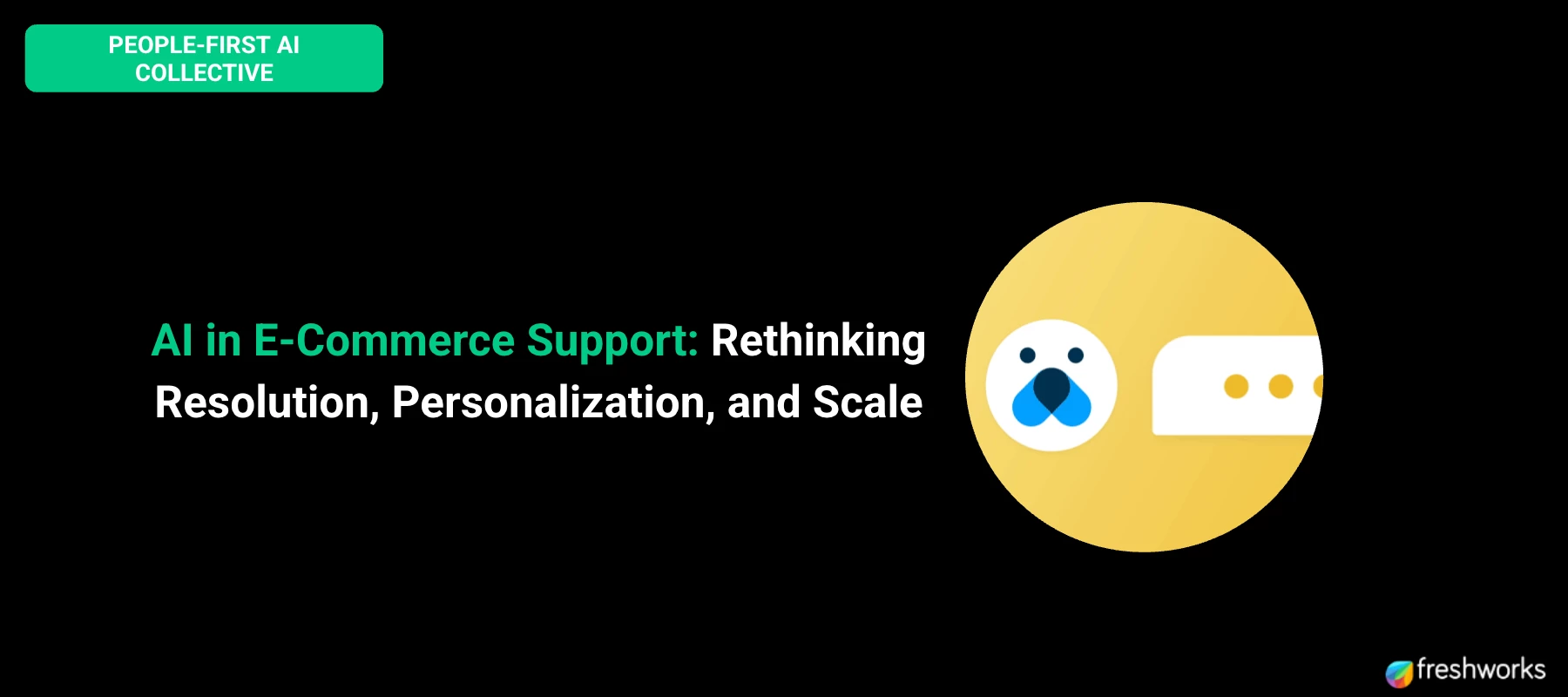Hello folks!
I’m
Not too long ago, the standard for good e-commerce support was: respond within 24 hours, be polite, and send a website link when asked. But customers have moved on, and fast. Today, “good” support is measured in seconds, not hours. At times, it is about anticipating problems, personalizing the response, and knowing when to let a human take over.
Enter AI: not as a replacement for human agents, but as an invisible layer of intelligence that helps brands resolve problems more efficiently, guide customers more effectively, and escalate issues more intelligently.
According to McKinsey, AI in customer service can reduce call volume by 30–40% and improve customer satisfaction scores by over 20%. Zendesk reports that 73% of customers now expect support to be more responsive, proactive, and personalized than just a year ago.
Here are five pivotal moments shaping the modern e-commerce experience, and how AI is revolutionizing each.
-
AI in E-Commerce Support: Rethinking Resolution, Personalization, and Scale
It might seem like a simple query, but “Where’s my order?” makes up nearly half of all inbound support volume for many brands. And during festive seasons or sale events, it can drown even the best-prepared teams.
But leading retailers have flipped this dynamic. Tech-first brands proactively send out chat notifications if an order is running late, often before the customer thinks to ask. One of Freshworks’ customers in the Middle East, a fast-growing online retailer, uses AI to fetch live shipping statuses and deliver them directly to WhatsApp. No ticket, no login.
For the customer, this is magic. For the agent, it’s a relief. With Freddy AI Agent plugged into the logistics APIs, over 40% of these queries are resolved without human intervention. And when the rare issue does escalate—say, a package lost in transit—Freddy Copilot summarizes the entire order trail and courier history for the agent, shaving minutes off resolution time.
When done well, AI turns the most repetitive support issue into a success story of trust and efficiency.
-
Simplifying Returns: How AI Streamlines Emotional, Complex Journeys
Returning a product isn’t just a process; an emotional journey and a logistical challenge rolled into one. Customers don’t want to feel like they’re negotiating with a bot or hunting through a dense FAQ page. They just want to know: “How can I return this? How fast will I get my refund? Will someone pick it up?”
A Southeast Asian fashion marketplace using Freshworks’ AI guides customers through this with remarkable grace. Their return workflow is dynamic, adjusting instructions based on product category, region, and payment method. No agent required. Their return bot understands which orders are eligible, triggers pickup scheduling, and keeps the customer in the loop, all within the chat itself.
AI here uses workflow builders and decision logic to map customer order history to business rules in real time. It identifies eligibility, routes actions (like pickup scheduling), and provides updates automatically, removing ambiguity.
When an edge case pops up, for example, a late return on a high-value product, the AI flags it to an agent, provides the policy breakdown, and offers suggested actions. This is AI not as a gatekeeper, but as a guide.
-
Managing Escalations Gracefully: Detecting Frustration Before It Spikes
No matter how slick your support stack is, there will be moments when customers are upset. A gift that didn’t arrive on time. A refund that’s taking too long. An experience that feels, simply, unfair.
This is the moment where AI must step back and also step in.
Enterprises need to use sentiment detection to spot frustration in real time. If a customer’s tone in chat or email becomes emotionally charged, the conversation is routed to a live agent, with urgency tags and full conversation history attached. A leading e-commerce platform in India, built on Freshworks, follows a similar playbook. Freddy Copilot detects emotional cues like “disappointed,” “angry,” or “unacceptable,” and ensures these conversations land in an agent’s queue faster with helpful summaries and a clear path to de-escalation.
These sentiment detection models rely on natural language processing (NLP) that parses keywords and tone indicators to determine customer mood, triggering an appropriate escalation when required.
What used to take 3–4 back-and-forths now starts with, “Hi, I see you’ve had a rough experience—let me make this right.” And that opening line makes all the difference.
AI, here, isn’t solving the problem directly. But it’s giving the human every chance to do it well.
-
Building Confidence to Buy: AI’s Role in Pre-Sales Product Exploration
Sometimes when customers are buying a product, they surely have questions: Will this shirt fit me? Is it compatible with my phone? What’s the warranty like if I’m ordering from another country?
These aren’t just questions for a help center, but also they’re moments of uncertainty. And in e-commerce, uncertainty kills conversion.
That’s why brands have invested in AI-guided product recommendation flows. Customers enter a few preferences—skin type, concerns, tone—and get curated suggestions. But they also have the option to talk to a person, with all their preferences carried forward.
A global beauty retailer using Freshworks does exactly this. Their Freddy-powered assistant helps customers explore products and makes personalized recommendations, while Freddy AI Agent equips the human agent (if needed) with the customer’s journey, likes, dislikes, and questions. The agent doesn’t start from scratch—they start informed.
The AI uses decision trees and product metadata to guide the shopper through contextual flows, increasing chances of relevance and conversion. Shopify reports that guided product journeys like these can increase conversion rates by up to 15%.
The result? Fewer drop-offs. Higher average order values. And customer conversations that feel like consultations, not cold calls.
-
Policy Clarity as a Growth Lever: Reducing Friction in the Final Mile
Delivery timelines. Return conditions. Warranty coverage. These aren’t exciting topics but they are make-or-break. If a shopper can’t figure out whether a product is returnable, or when it will arrive, chances are they won’t buy it at all.
Brands have addressed this by embedding AI that dynamically fetches policy snippets based on what the shopper is looking at. If you’re browsing a sofa in Denver, the chat widget might offer: “This product will be delivered in 5–7 days and comes with a 10-year warranty.”
An electronics D2C brand in APAC, built on Freshworks, uses Freddy AI Agent to do something similar. The AI pulls region-specific policies, detects if a promotion overrides a default return window, and even suggests answers to agents when escalation occurs.
This is enabled by AI models that index business policies and map them to product SKUs, user location, and cart context, serving accurate, relevant snippets without needing the customer to search or wait.
Customers don’t want to read pages of policy info document; it comes to them. That convenience is often what tips a hesitant visitor into a confident buyer.
Where This Leaves Us: Practitioners, Be Curious. Be Cautious.
The temptation with AI is to automate everything. But in e-commerce, success doesn’t come from replacing people—it comes from creating a layered, intelligent system where AI handles the predictable, and humans shine in the moments that matter.
If you’re leading CX in retail or D2C, here are a few truths worth remembering:
-
Your AI is only as good as your data. Clean inventory, clear policies, and consistent tagging are non-negotiables.
-
Escalation isn’t failure; it’s a design opportunity. Let AI detect emotion and hand off with grace.
-
Don’t just measure ticket deflection. Track how many problems were solved before they became complaints.
At Freshworks, we’ve seen e-commerce teams from regional fashion startups to global brands use AI to transform their support from reactive to predictive, and from functional to delightful. The tools are there. The key is to use them in ways that respect the customer’s time and intelligence.
Because at the end of the day, customers don’t want to “talk to AI.” They want to be heard, and helped.
If there’s a specific industry you’d like me to dive deeper into, drop a comment below! I’ll be happy to come back with tailored best practices and insights.
Cheers
Saurabh




